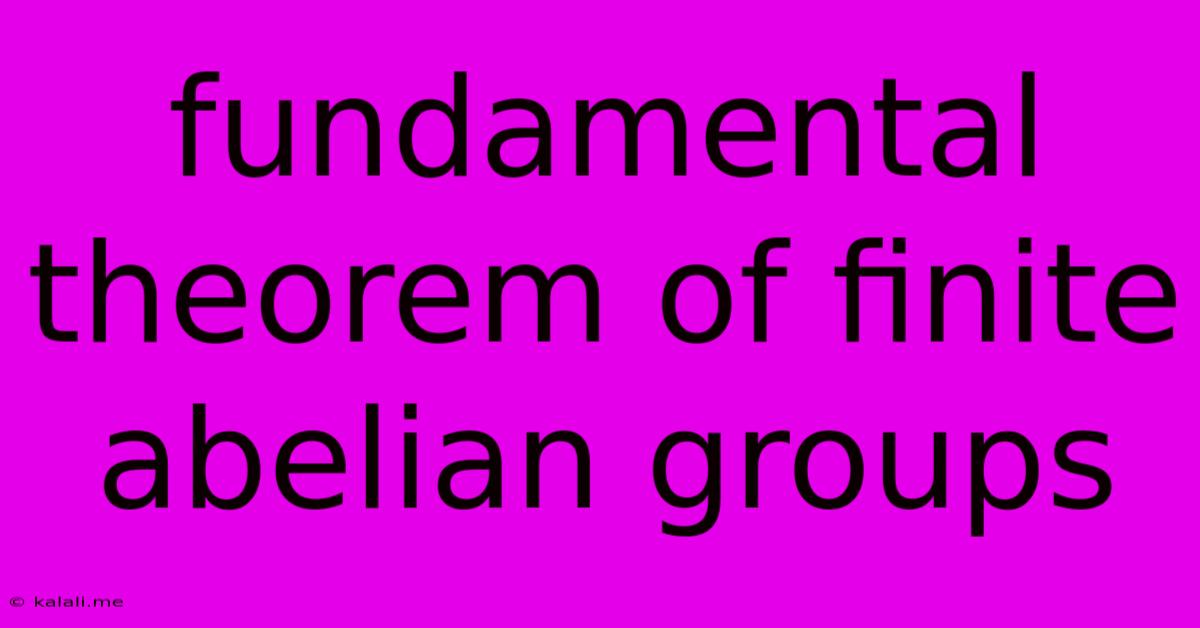Fundamental Theorem Of Finite Abelian Groups
Kalali
Jun 10, 2025 · 4 min read

Table of Contents
The Fundamental Theorem of Finite Abelian Groups: A Deep Dive
The Fundamental Theorem of Finite Abelian Groups is a cornerstone result in abstract algebra, providing a powerful classification of all finite abelian groups. Understanding this theorem unlocks insights into group structure and simplifies many algebraic computations. This article will explore the theorem itself, its proof (at a high level), and its significant implications. We'll also look at some examples to solidify understanding.
What the Theorem States:
The theorem states that every finite abelian group can be expressed as a direct sum of cyclic groups of prime power order. More formally: Every finite abelian group G is isomorphic to a direct sum of cyclic groups of the form Z<sub>p<sup>e</sup></sub>, where p is a prime and e is a positive integer. This decomposition is unique up to the order of the summands. This means that while different decompositions might exist, the number of summands of each order will always be the same.
Understanding the Key Concepts:
Before diving deeper, let's clarify some fundamental concepts:
- Abelian Group: A group where the operation is commutative (a * b = b * a for all elements a and b in the group).
- Cyclic Group: A group generated by a single element. Z<sub>n</sub> (the integers modulo n) is a classic example of a cyclic group.
- Direct Sum: A way of combining groups to create a larger group. For groups G and H, their direct sum (G⊕H) consists of ordered pairs (g,h) where g∈G and h∈H.
- Prime Power Order: The order (number of elements) of a group is a power of a prime number (e.g., 2<sup>3</sup> = 8, 3<sup>2</sup> = 9).
- Isomorphism: A structure-preserving mapping between two groups. If two groups are isomorphic, they are essentially the same group, just with different labels on the elements.
Proof Outline (High-Level):
A rigorous proof involves several steps and typically leverages techniques from module theory. However, a high-level outline can be presented:
-
Invariant Factor Decomposition: The first part involves showing that any finite abelian group can be expressed as a direct sum of cyclic groups with orders that are factors of each other (invariant factors). This decomposition is unique.
-
Primary Decomposition: The next crucial step involves decomposing each cyclic group from the invariant factor decomposition into its primary components. This uses the fact that any integer can be uniquely factorized into primes. This shows that the group can be represented as a direct sum of cyclic groups whose orders are powers of primes.
-
Uniqueness: The final part establishes the uniqueness of this decomposition up to the order of summands. This part is the most technically involved and relies on properties of the group's structure.
Examples:
Let's illustrate the theorem with a couple of examples:
-
Z<sub>12</sub>: The cyclic group of order 12 can be decomposed as Z<sub>12</sub> ≅ Z<sub>4</sub> ⊕ Z<sub>3</sub> (because 12 = 4 * 3 and gcd(4,3) = 1).
-
Z<sub>18</sub> ⊕ Z<sub>6</sub>: This group can be decomposed as Z<sub>18</sub> ⊕ Z<sub>6</sub> ≅ Z<sub>2</sub> ⊕ Z<sub>9</sub> ⊕ Z<sub>2</sub> ⊕ Z<sub>3</sub> ≅ Z<sub>2</sub> ⊕ Z<sub>2</sub> ⊕ Z<sub>3</sub> ⊕ Z<sub>9</sub>. Note the different orderings of the summands. This illustrates the 'up to isomorphism' aspect of the theorem's uniqueness.
Significance and Applications:
The Fundamental Theorem of Finite Abelian Groups has far-reaching consequences:
- Classification: It provides a complete classification of all finite abelian groups. This allows for systematic study and understanding of their properties.
- Simplification: It simplifies many computations related to finite abelian groups by allowing us to work with simpler cyclic groups instead.
- Representation Theory: It plays a crucial role in representation theory, particularly in the classification of irreducible representations of finite abelian groups.
- Cryptography: It has applications in various areas of cryptography, including the design and analysis of cryptographic systems.
This theorem provides a powerful tool for studying and understanding finite abelian groups. Its elegance and usefulness make it a cornerstone result in abstract algebra, with significant ramifications in various branches of mathematics and computer science. Further exploration of the proof and applications would deepen one's understanding of this profound result.
Latest Posts
Latest Posts
-
One Thousand One Hundred And Fifty
Jun 12, 2025
-
What Letter Is In The Middle Of The Alphabet
Jun 12, 2025
-
Composite Numbers From 1 To 1000
Jun 12, 2025
-
Which Planets Do Not Have Moons
Jun 12, 2025
-
Is A Venus Flytrap More Efective Than Pitcher Plant
Jun 12, 2025
Related Post
Thank you for visiting our website which covers about Fundamental Theorem Of Finite Abelian Groups . We hope the information provided has been useful to you. Feel free to contact us if you have any questions or need further assistance. See you next time and don't miss to bookmark.